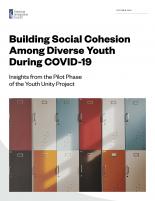- Special Report
Building Social Cohesion Among Diverse Youth During COVID-19
Insights from the Pilot Phase of the Youth Unity Project
Published
The United States has a long, complex history of immigration that has shaped how we view the country—its strengths, its shortcomings, as well as its promise to be a sum greater than its parts. For us to reach our fullest potential as individuals and as a nation, it is incumbent on us to understand and explore our many immigration journeys.
However, public debate around immigration is more divisive now than it has been in generations. Throughout the COVID-19 crisis, this widening divide has quickly created an environment in which youth, both new immigrants and those within the receiving community, feel less connected, engaged, and empowered to create their own, bold vision for a cohesive nation.
What began before the global pandemic as a kernel of an idea between YMCA of the USA (Y-USA) and New American Economy (now the American Immigration Council) suddenly gained new urgency and meaning. Both organizations, committed to equity, inclusion, and the celebration of diversity, recognized that the potential to attain these values begins with young people. It was with this vision that the Youth Unity Project began to take shape.
The Youth Unity Project, a joint effort created by Y-USA and the Council, connects young, new immigrants with young people in their respective receiving communities and teaches them about immigration in the United States. Throughout the process, the young people engage on issues related to social justice, belonging, and social cohesion.
- Educate participants on the basics of the U.S. immigration system;
- Foster meaningful cross-cultural engagement and cooperation between immigrant youth and receiving- community youth;
- Increase the likelihood that participants pursue civic engagement and community involvement beyond the program; and,
- Train a cohort of young leaders to educate and facilitate productive dialogue around the immigration issue among diverse youth.
The key to meeting these goals starts with youth empowerment and education in spaces—both virtual and physical— that bring immigrant youth and receiving-community youth together. In 2021, the pilot phase of the Youth Unity Project took place in 10 YMCA locations across the country. Conducted over 9 and 12 weeks with one to two sessions per week, the pilot project recruited 207 youth participants; 15 percent of the participants were immigrants and 68 percent were the children of immigrants.
- Increasing understanding of the U.S. immigration system: In the pre-program survey, 34 percent of the participants reported they had learned nothing in school about the U.S. immigration system and 62 percent said they had learned only a little. After completing the program, the share of the participants who said they knew some or a lot about the U.S. immigration system increased from 46 percent in the pre-program survey to 80 percent in the post-program survey.
- Encouraging critical thinking: About 53 percent of participants said the program made them think differently about how they read the news. The share of participants who believed that immigration is good for America also increased from 74 percent to 84 percent.
- Promoting cross-cultural dialogue and understanding: After going through the program, higher shares of participants reported they talked with other young people from different cultures or ethnic backgrounds (from 78 percent in the pre-program survey to 90 percent in the post-program survey), while being able to find more similarities among them (from 78 percent to 86 percent).
- Developing appreciation of differences and awareness of bias: The program helped more participants develop a strong connection to their own family’s immigration history and cultural background (from 66 percent to 83 percent). A higher share of participants also reported being aware of their own biases around skin color, language, appearance, age, or religion (from 80 percent to 88 percent). Additionally, when communicating with people from different backgrounds, many participants found it most difficult to overcome language barriers and handle issues related to biases, racism, and privileges. About 43 percent of participants reported this program made them feel more comfortable communicating with a diverse group of people.
- Fostering social cohesion and civic engagement: Nearly 62 percent of the participants felt division in the country, their community, or their home. Many think we can become less divided through education, communication and connection, and advocacy. After finishing the program, participants were more likely to feel a strong connection to their communities (from 64 percent to 72 percent) and volunteer or help others (from 53 percent to 69 percent).
Help us fight for immigration justice!
The research is clear – immigrants are more likely to win their cases with a lawyer by their side. But very few can get attorneys.
Introducing the Immigration Justice Campaign Access Fund.
Your support sends attorneys, provides interpreters, and delivers justice.

Immigration Justice Campaign is an initiative of American Immigration Council and American Immigration Lawyers Association. The mission is to increase free legal services for immigrants navigating our complicated immigration system and leverage the voices and experiences of those most directly impacted by our country’s immigration policies to inform legal and advocacy strategies. We bring together a broad network of volunteers who provide legal assistance and advocate for due process for immigrants with a humane approach that includes universal legal representation and other community-based support for individuals during their immigration cases.

